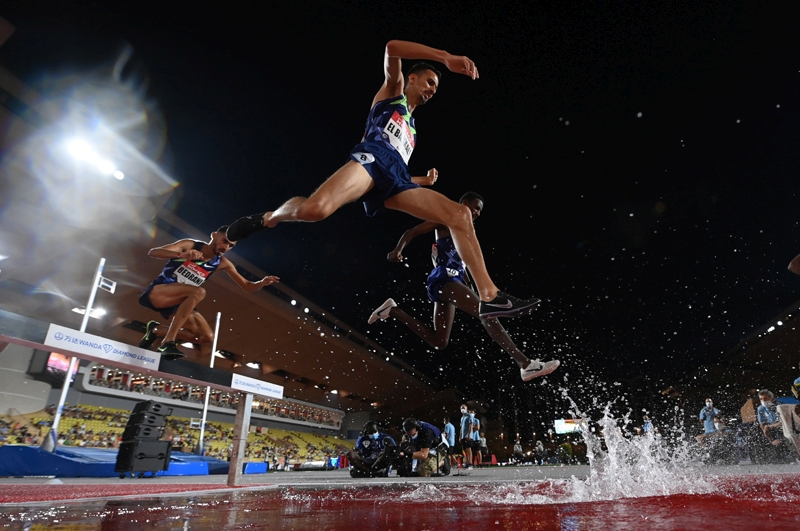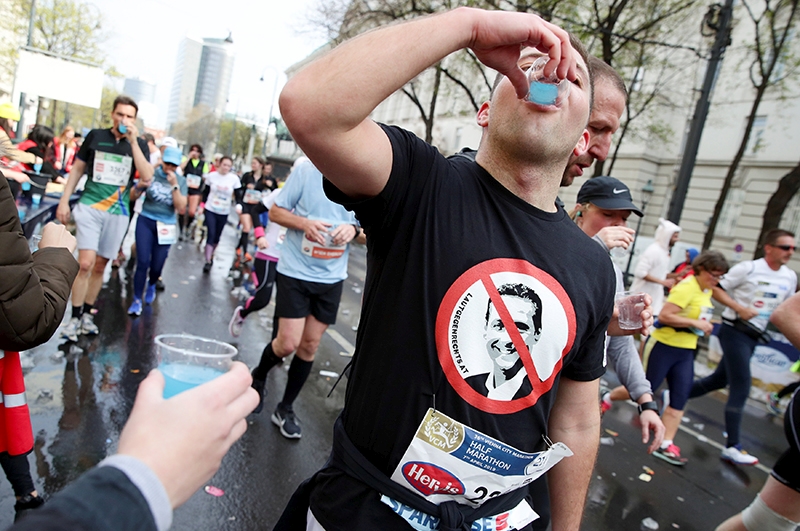You are viewing 1 of your 1 free articles. For unlimited access take a risk-free trial
Carbohydrate feeding: sleeping low for superior endurance!
New research shows that a targeted restriction of carbohydrate intake after intense training can yield endurance performance dividends

New research shows that a targeted restriction of carbohydrate intake after intense training can yield endurance performance dividends
Carbohydrate is the body’s preferred fuel for high-intensity exercise because stored muscle carbohydrate (glycogen) can be rapidly broken down to release energy in the working muscles. And while fat is also a very useful source of fuel for exercise, its oxidation for energy requires more oxygen consumption compared to carbohydrate; Since oxygen supply to the muscles is strictly limited by an athlete’s ‘maximum aerobic capacity’, getting as much ‘energy bang per buck’ from the oxygen consumed is vital – hence the advantage of carbohydrate as a fuel source, especially during intense exercise (see figure 1).
Figure 1: Energy contribution from fat with increasing intensity

Although fat oxidation is vital for more moderate exercise intensity, at high intensities (over 80% VO2max - the kind required for competition and racing), carbohydrate oxidation is the key to performance.
Too much of a good thing?
The energetics of carbohydrate oxidation explains why for many decades, most sports nutritionists have recommended the use of a high-carbohydrate diet to maximize endurance performance(1). However, despite the advantages of fueling exercise with carbohydrate, there are also drawbacks. Firstly, the amount of carbohydrate storage within muscles as muscle glycogen is also limited, which means that as the duration of exercise increases and intensity decreases, fat burning becomes ever more important. Therefore, total reliance on carbohydrate for fueling is not recommended for long-duration events.
In more recent years, a number of sports physiologists have gone further than this and theorized that when it comes to carbohydrate intake, endurance athletes could have too much of a good thing and that some carbohydrate deprivation could actually be a good thing. In short, researchers have questioned whether always training with abundant carbohydrate available – ie while consuming a high-carbohydrate diet and carbohydrate drinks and gels when on the move – is wise.
Why would this be the case? In simple terms, if muscles are always trained with ample carbohydrate to draw on, fat adaptation may not not maximized – ie the muscles will not become as efficient at fat burning as they could be because they’re not frequently trained in a carbohydrate-depleted state(2). Although not an issue for shorter-duration events, sub-optimal fat adaptation does matter for longer events such as the marathon and particularly for ultra events because at these distances, glycogen depletion can become a real problem, which means good fat burning becomes essential(3).
A targeted approach
For the reasons given above, a number of sports nutritionists have argued that a more targeted approach to carbohydrate intake, with some periods of low-carbohydrate intake could produce superior results. The theory is that by undertaking some training in a carbohydrate-depleted state, the process of fat burning can be upregulated. There’s excellent biochemical and genetic evidence for this approach; compared with loaded glycogen stores, training with reduced muscle glycogen stores has been shown to increase an enzyme called ‘AMP-activated protein kinase’ (AMPK)(4).
Why does that matter? Well, AMPK acts as a cellular ‘energy sensor’ in muscles. When it detects low energy (ie low muscle glycogen stores during exercise) it increases the activity of a key signalling molecule called PGC-1α(5). Increased PGC-1α activity then activates genes associated with mitochondrial synthesis – ie switches on genes that manufacture new mitochondria(6,7). The mitochondria can be considered the aerobic energy factories in cells; the more mitochondria per unit volume of muscle, the greater the aerobic energy producing capacity. It’s hardly surprising then that stimulating the synthesis of more muscle mitochondria is a key hallmark of endurance training adaptation(8). In short then, performing training sessions when carbohydrate levels in the muscles are low should stimulate AMPK and the production of the signalling molecule PGC-1α, which then switches on genes responsible mitochondria production, resulting in more mitochondrial density and better endurance performance.
Credit Agricole rider Stuart O’Grady of Australia (R) feeds himself as he rides ahead of red jersey holder of best climber in the 211km sixth stage of the Tour de France cycling race from Commercy to Strasbourg in eastern France July 13, 2001. O’Grady retained his yellow jersey of overall leader after the fifth stage.
In the real world
That’s the theory, but does this approach work in the real world? After all, there are significant drawbacks to training in a depleted or low-carbohydrate state. The biggest is that when muscle glycogen levels are low, the potential quality of any training session will be inevitably reduced. In particular, it’s extremely difficult to carry out high-intensity training when glycogen depleted, yet we know that high-intensity sessions (eg intervals) are both effective and necessary for increasing endurance performance(9). The other issue is that a carbohydrate-restriction strategy that works in the lab might not work for a real athlete in the real world. The question is therefore, how do the pros and cons of periodized carbohydrate intake balance out, and are there any specific carbohydrate-restriction strategies that are easily implemented outside of the lab and which are likely to be successful? One targeted carbohydrate restriction that has been trialled in studies is the so called ‘sleep low, train low’ strategy. This includes three different training-nutrition interventions:
- A bout of high-intensity training (HIT) in the evening to deplete muscle glycogen stores.
- No post-exercise carbohydrate feeding to ensure low carbohydrate availability overnight (sleeping low).
- A bout of low-intensity training (LIT) the next morning under conditions of low muscle glycogen/CHO availability – ie before breakfast.
The sleep low, train low model is thought to be particularly suitable for athletes because the timing of exercise and carbohydrate restriction means that the number of waking hours an athlete has to endure in the low-carbohydrate state (ie hungry!) is minimized even though the actual hours spent in that state are considerable, which potentially maximises the adaptation response(10). But how effective is this approach?
One study on triathletes observed that a 3-week sleep low, train low intervention reduced body fat by 1.1% fat mass, improved 10-km running performance by 2.9%, and hiked cycling efficiency at submaximal speeds by 11.7% when compared to training in conditions of consistently high carbohydrate availability(11). By contrast, a study on cyclists found that a 4-week sleep low, train low intervention produced no benefits over normal carbohydrate consumption(12). Why the conflicting results? The most likely explanation is that these interventions failed to report on the ability of the athletes to complete the desired workload while they were in the low-carbohydrate state. Given that reduced carbohydrate availability impairs exercise capacity and may impact session quality, it may well have been that the cyclists in the sleep low, train low group were not able to train equally hard as those in the control group, which negated any advantages that a sleep low, train low strategy brings.
A new approach
A major problem when assessing something like sleep low, train low over a period of weeks is that laboratory-based training studies have severe limitations. Not only do they impose a burden on participants who must report daily to the research facility, many training sessions are often completed away from the laboratory environment, thus reducing the opportunity for data collection by the research team. However, brand new research published in the journal PLOS ONE has sought to provide a definitive answer on the validity of sleep low, train low by studying athletes in the home environment - but using high-quality intensity monitoring and remote data collection to ensure that both the sleep low, train low and control groups perform exactly the same workloads during the intervention(13).
In this 3-week study by UK scientists, 55 cyclists and triathletes were matched for fitness levels then randomly assigned to either: a sleep low, train low group; a control group. During the next three weeks, all the participants followed the same exercise program. The weekly training program was comprised of six sessions over four days, including high-intensity (HIT) sessions in the evenings, and low-intensity (LIT) sessions the following mornings.
The training intensity was standardized across all participants and prescribed relative to each athlete’s ‘functional threshold power’ (FTP for short). FTP is the highest theoretical steady-state power output a cyclist can maintain for approximately 60 minutes. FTP is important because it has been shown to be a positive predictor of cycling performance, and a better predictor of mass start cycling performance (eg triathlon competitions) than VO2max(14). In this program, the LIT sessions consisted of 60 minutes of cycling at 75% FTP, whilst HIT sessions consisted of six sets of 5 minutes cycling at 105% FTP, each set interspersed with 5 minutes of active recovery at 55% of FTP.
Home training
All the training sessions were performed at home, using the athletes’ own equipment and recording all their own data. Power output recoded via a power meter or smart trainer. Participants reported their power meter brand and model to the research team and were instructed to complete a factory calibration for power meters and spin-down calibration for home trainers at the start of each week of the study. Immediately post exercise, participants were asked to upload data files to the online platform and rate their perceived exertion for the entire session via the online software (within 15 minutes of exercise completion). All participants’ training sessions were prescribed at the start of the study and overseen throughout by a central coach account where data could be exported for analysis. The importance of structuring the training this way is that a) it allowed the athletes to train in a much more normal fashion (ie without continually trekking off the lab) and b) it allowed the researchers to ensure that the training sessions prescribed were completed fully and at the right intensity.
Nutritional differences
In terms of nutrition, all the followed prescribed meal plans that consisted of the same total fat/protein/carbohydrate intake, the only difference being the timing of carbohydrate intake. Therefore the total daily carbohydrate intake was exactly the same for each group (6 grams per kilo of bodyweight per day), but the intake was distributed differently throughout the day to achieve either low intake or normal intake around the sleep low or control sessions respectively. Carbohydrate consumption was prohibited in the period between the completion of HIT and LIT sessions in sleep low, train high group and no carbohydrate was consumed during any training session. By contrast, the control group had free carbohydrate availability throughout the day (up to 6 grams per kilo per day). For a detailed overview of the precise structure of how the sleep low, train low and control groups structured training and nutrition, see this table.
What they found
Before and after the 3-week intervention, all the athletes were assessed for key indicators of fitness, which included:
- Functional threshold power (FTP)
- 1 and 5-minute peak power outputs
- Perception of effort at specific workloads
- Percentage of max heart rate at specific workloads
The main findings were as follows:
- FTP in the sleep low, train low athletes increased by 5.5%, significantly more than the control athletes (1.2%) – see figure 2.
- 20-minute peak power output increased more (by 3.2%) in the sleep low group compared to the control group (1.2% - see figure 2).
- 5-minute peak power outputs gains were seen in both groups, with no significant difference between the groups.
- The 1-minute peak power output was unchanged in the sleep low group but improved by 3.9% in the control group.
- In the sleep low, train low group, LIT exercise intensity reduced by 3% across weeks 1 and 3 and 2% in week 2, with elevated perceived exertion (presumably accumulating fatigue from the low-carbohydrate training. No such drop was seen in the control group.
Figure 2: Changes in FTP and 20-minute peak power

Each line with before and after dots attached represents an athlete. Significantly greater gains were seen in 20-minute peak power (left) and FTP (right) in the sleep low athletes (SL) compared to controls (CON).
What are the implications for endurance performance?
These results led the researchers to conclude a number of things. Firstly, home-based performance testing and monitoring using uploaded data files proved to be extremely effective, and can therefore form a highly reliable strategy for athletes and coaches to monitor training program effectiveness over time. Providing diet and physical activity prior to performance testing is standardized, coaches and athletes can expect 2% or less variation between repeated trials, which is extremely impressive.
When it came to actual performance, it was true that despite the best efforts of high-carbohydrate feeding following each sleep low, train low cycle in the program, the athletes in this group nevertheless experienced a progressive increase in fatigue and slightly reduced work output in their morning low-intensity sessions. However, this did not seem to prevent significant endurance performance gains; 5.5% in FTP in just three weeks is mightily impressive! Conversely, there was no gain in very high-intensity power output (1-minute peak power), which suggests a sleep low, train low strategy will not benefit athletes whose events are less shorter (less than 10 minutes or so).
In terms of applying this research, there seems much to gain and little to lose for endurance athletes, especially as this study shows that it’s highly practical to do at home both in terms of getting the nutrition and the training sessions correct (providing you have a power meter). Here then are some tips:
- Using this approach will first require you to carry out an FTP test (since all training intensities are calculated using %FTP). If you don’t already have the software to allow you to calculate this, it may be worth investing in some.
- Sleep low, train low interventions should be kept to three weeks duration maximum; any longer is likely to result in undesirable levels of fatigue.
- Use the protocol set out here to structure your training and post-training nutrition when performing sleep low, train low.
- Use sleep low, train low only once your fitness levels are well advanced – ie don’t use it when you are still building base fitness for the season.
- Use sleep low, train low sparingly, and in a targeted manner for a competition; time its use so that the intervention is completed two weeks before the competition so that you are fresh and fully recovered, but still have the fitness benefits of increased FTP.
- Do not use sleep low, train low when you’re feeling stressed, tired or unwell; the extra physiological stress of low-carbohydrate training could make you worse off than taking it easy!
- Sleep low, train low is not suitable for novices or those without a good endurance base. These athletes should concentrate on the fundamentals before experimenting.
References
- Sports Med (Auckland, NZ). 2013;43(11):1139–55
- Nutrients. 2018 Mar 2; 10(3):
- Metabolism. 2016 Mar;65(3):100-10. doi: 10.1016/j.metabol.2015.10.028
- Cell Metab. 2009 Jan 7; 9(1):23-34
- Curr Opin Lipidol. 2009 Apr; 20(2):98-105
- Cell Metab. 2005 Jun; 1(6):361-70
- Nature. 2002;418(6899):797–801
- Appl Physiol Respir Environ Exerc Physiol. 1984;56(4):831–8
- Scand J Med Sci Sports. 2015 Dec;25 Suppl 4:88-99
- Nestle Nutr Inst Workshop Ser. 2013; 75():1-14
- Med Sci Sports Exerc. 2016 Apr; 48(4):663-72
- Scand J Med Sci Sports. 2019 Dec; 29(12):1866-1880
- PLoS One. 2021; 16(12): e0260959
- Sports (Basel). 2019 Oct 1; 7(10):
Newsletter Sign Up
Testimonials
Dr. Alexandra Fandetti-Robin, Back & Body Chiropractic
Elspeth Cowell MSCh DpodM SRCh HCPC reg
William Hunter, Nuffield Health
Newsletter Sign Up
Coaches Testimonials
Dr. Alexandra Fandetti-Robin, Back & Body Chiropractic
Elspeth Cowell MSCh DpodM SRCh HCPC reg
William Hunter, Nuffield Health
Keep up with latest sports science research and apply it to maximize performance
Today you have the chance to join a group of athletes, and sports coaches/trainers who all have something special in common...
They use the latest research to improve performance for themselves and their clients - both athletes and sports teams - with help from global specialists in the fields of sports science, sports medicine and sports psychology.
They do this by reading Sports Performance Bulletin, an easy-to-digest but serious-minded journal dedicated to high performance sports. SPB offers a wealth of information and insight into the latest research, in an easily-accessible and understood format, along with a wealth of practical recommendations.
*includes 3 coaching manuals
Get Inspired
All the latest techniques and approaches
Sports Performance Bulletin helps dedicated endurance athletes improve their performance. Sense-checking the latest sports science research, and sourcing evidence and case studies to support findings, Sports Performance Bulletin turns proven insights into easily digestible practical advice. Supporting athletes, coaches and professionals who wish to ensure their guidance and programmes are kept right up to date and based on credible science.














